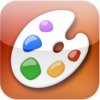I've become more comfortable. I've made the time. Here is one simple way I have found that requires students to create, to share, and to be critical. I linked my class to a common dropbox account and had them set up folders on it. We had just wrapped up a poetry unit and every student had a few final products. I told them to choose their best one and figure out a way to publish it to dropbox so that others could look at it for ideas.
Here are a few of the apps the students chose to use prior to submitting an image to dropbox:
Comic Life
Students used Comic Life to create a dialogue base for presenting their poetry. Some students just created a comic strip and then submitted it, but others spurred them on by opening their comic strip in brushes and making it look better. One student took it to brushes and then to LifeCards so that she could add more description to her poem - awesome.
DoodleBuddy
Students used DoodleBuddy for a couple of purposes. It is many of the students' go-to app for artistic creation because of its simplicity. Like brushes you can open up saved images for editing, but it is not as precise. Mostly, students chose DoodleBuddy to create a simple image or two and then opened those images up in LifeCards.
Brushes
 Students used Brushes to do precise editing on images they had created in LifeCards or DoodleBuddy. A few students became 'Brushes evangelists' because of the ability to layer pictures. They walked around showing students what they had figured out and they started to get into the intricacies of the app. Brushes works great to edit out unwanted parts of a screen shot, this turned out to be its hottest use for this lesson
Students used Brushes to do precise editing on images they had created in LifeCards or DoodleBuddy. A few students became 'Brushes evangelists' because of the ability to layer pictures. They walked around showing students what they had figured out and they started to get into the intricacies of the app. Brushes works great to edit out unwanted parts of a screen shot, this turned out to be its hottest use for this lesson.
LifeCards
Students used LifeCards if they wanted to add substantial text to their submission. They would create an image in DoodleBuddy or Brushes or GlowDoodle and then insert that picture into LifeCards and write 2-3 paragraphs to go with it. The image creation apps often permit small text boxes, but some student's poems were very long and they needed the ability to write more text clearly.
Google Earth
Some students used Google Earth just because they thought it was cool. Others used it because they had a poem about the city or the ocean and they wanted an image of that setting - I didn't expect this to come into play.
Google Maps
In the same way as students used Google Earth, students used Maps to capture an image of their house, the school, the city, or whatever it was that matched their topic. I only had a few use this app to find an image for their work but it was fun to have an actual picture of the park or restaurant instead of only a simple picture from DoodleBuddy or GlowDoodle.
GlowDoodle
GlowDoodle was good for students to create a simple image to stood out. For students that wrote poems using onomatopoeia they found this app useful for supplementing their poetry. How else do you accurately show "woof" or "bang" with an image?
The assignment to layer apps, or to use multiple apps to reach an end product, was fun to watch blossom. It is one of the things about teaching that I love the most - giving students freedom and discovering that they are capable of doing some amazing thinking.
Ultimately, if I can not envision an end product to something I am assigning, I don't assign it.
Likewise, if I can only envision one end product to an assignment where students are publishing their thoughts/knowledge, I don't assign it.
Thanks for reading. What other apps are well designed for layering and creative use?






Next year I hope to use instagram, connected to a private flickr account to share with parents.
ReplyDeleteGreat thoughts here. I am working through my own thinking about multi-app possibilities for the secondary reading classroom, both in terms of offering choices and in layering. Like you, I like to work through the kinks and have a visions for end product possibilities. No time to waste, only to be authentically creative. Since NW received their iPads so late in the year, I feel like I am still in the discovery process.
ReplyDeleteCooper, I would just encourage you to let your kids show you what they can do. Teach them how to take a screenshot and show them some apps they could 'layer' and then challenge them to come up with a cool product to show you what they know. Most of the apps above were discovered by my students.
ReplyDeleteTheir ownership over the process was key.